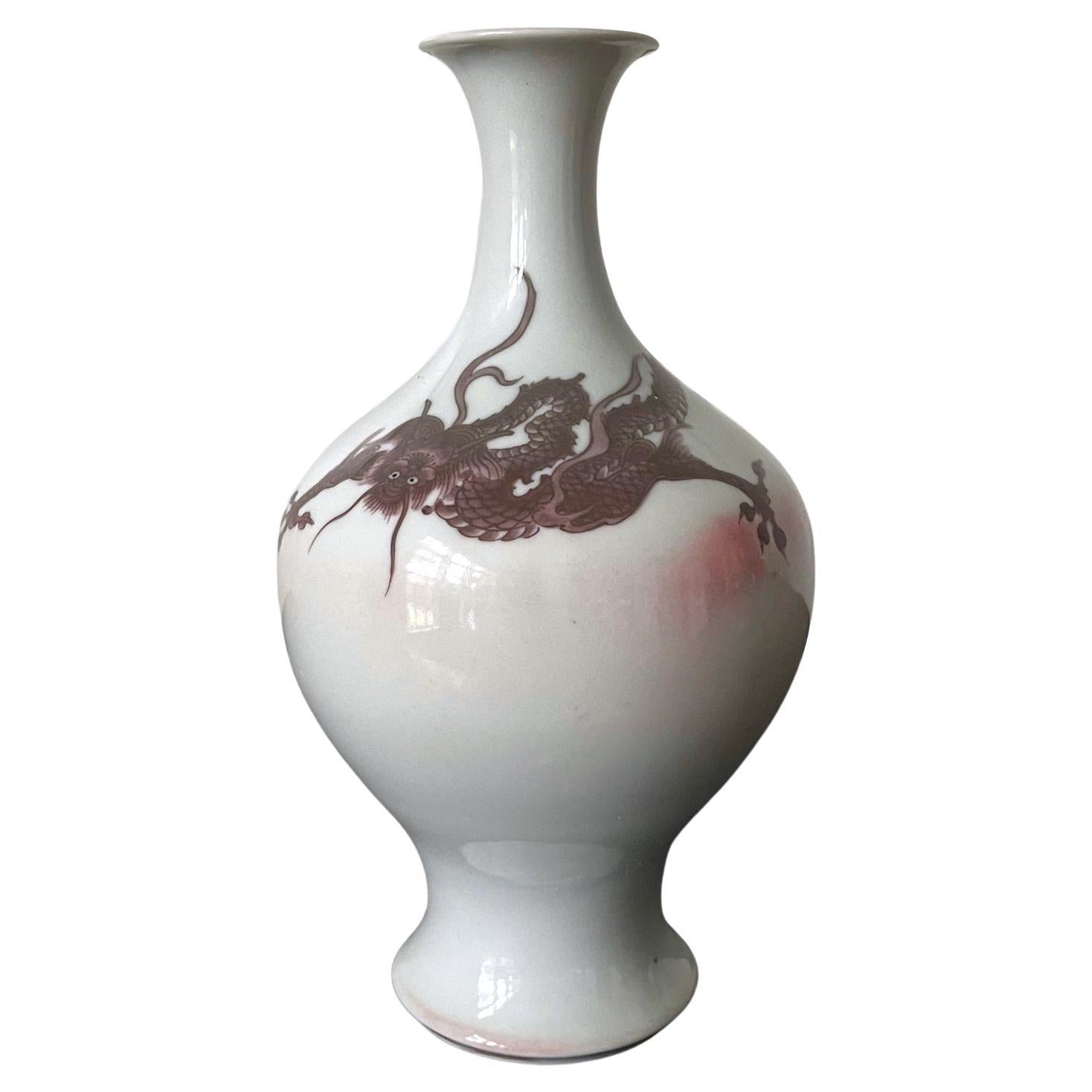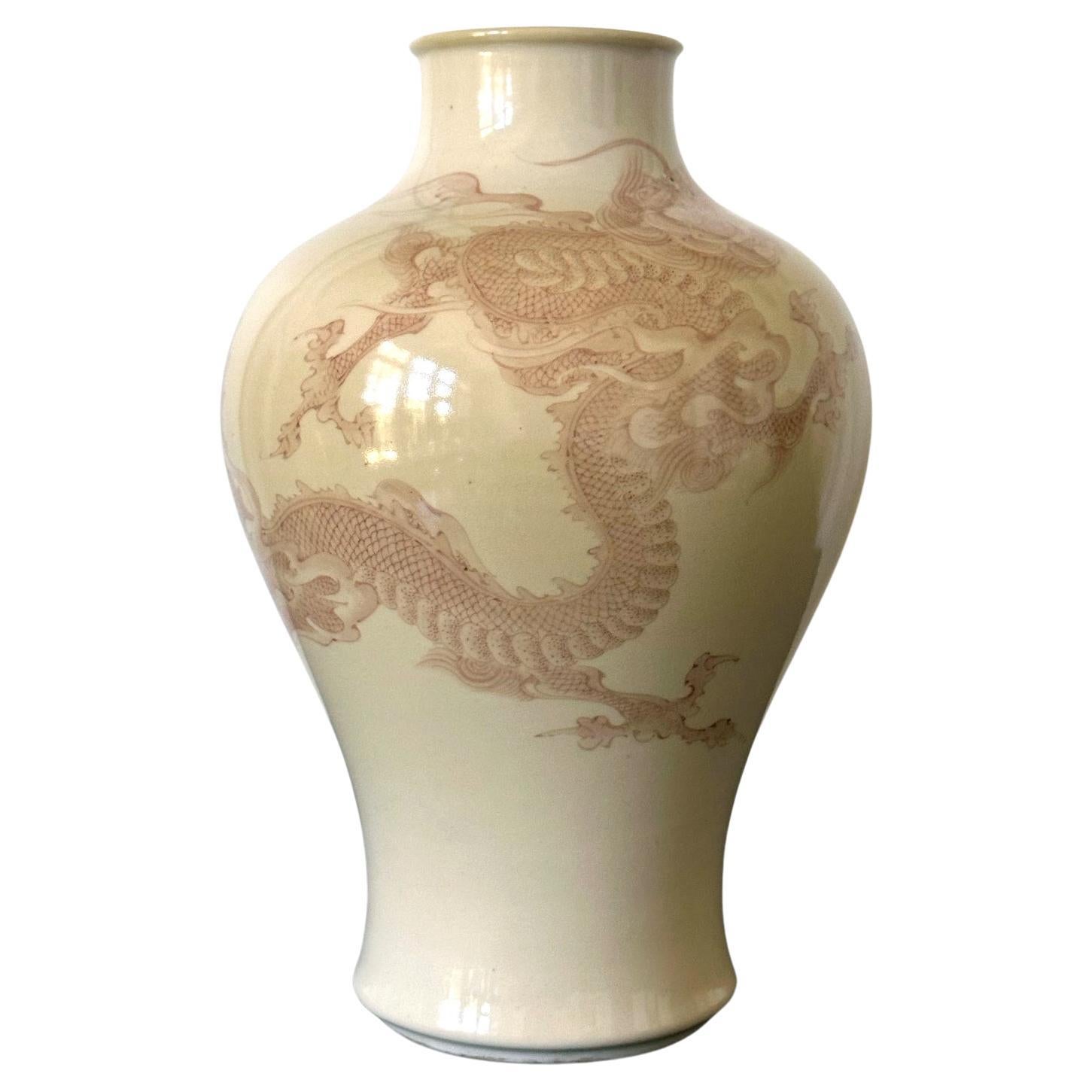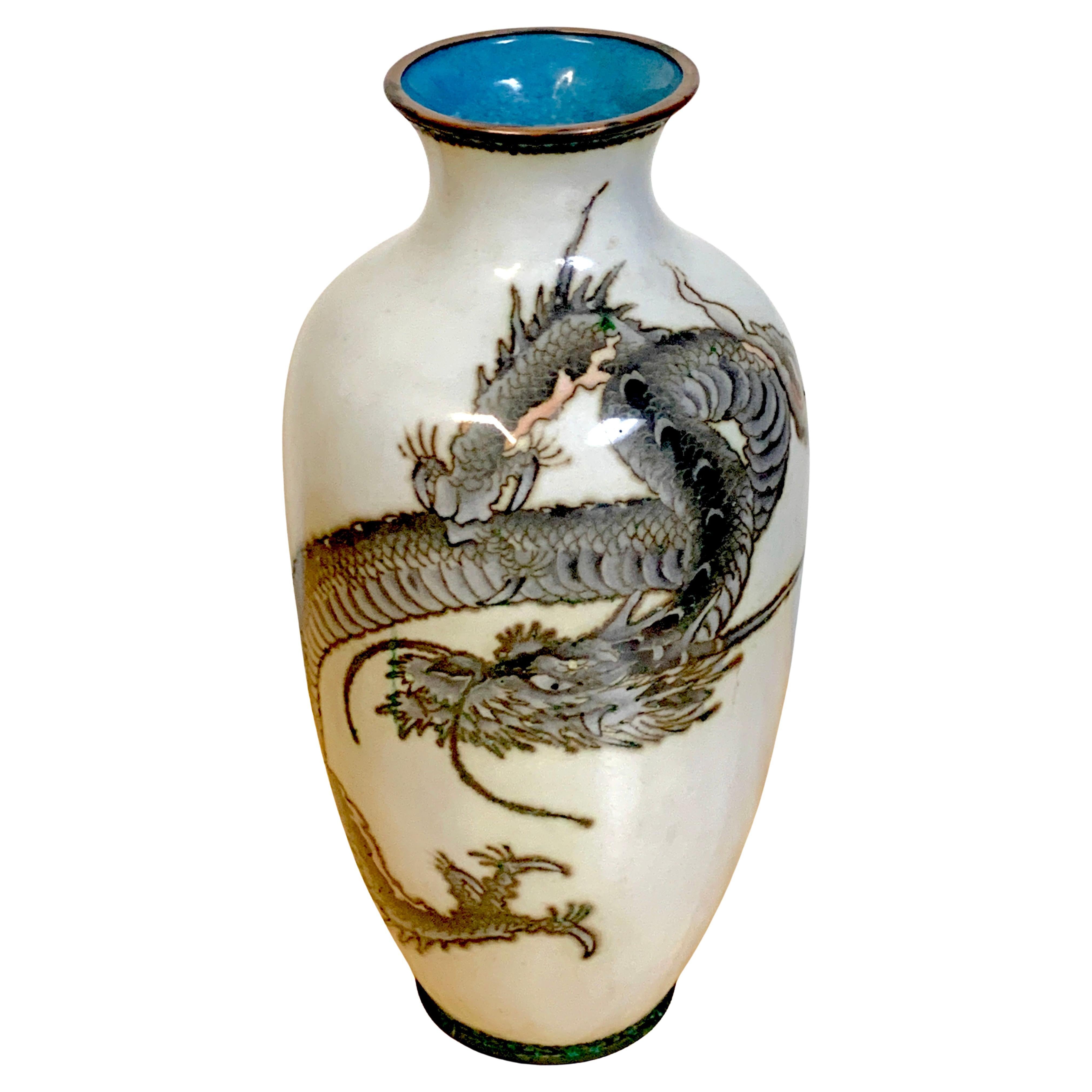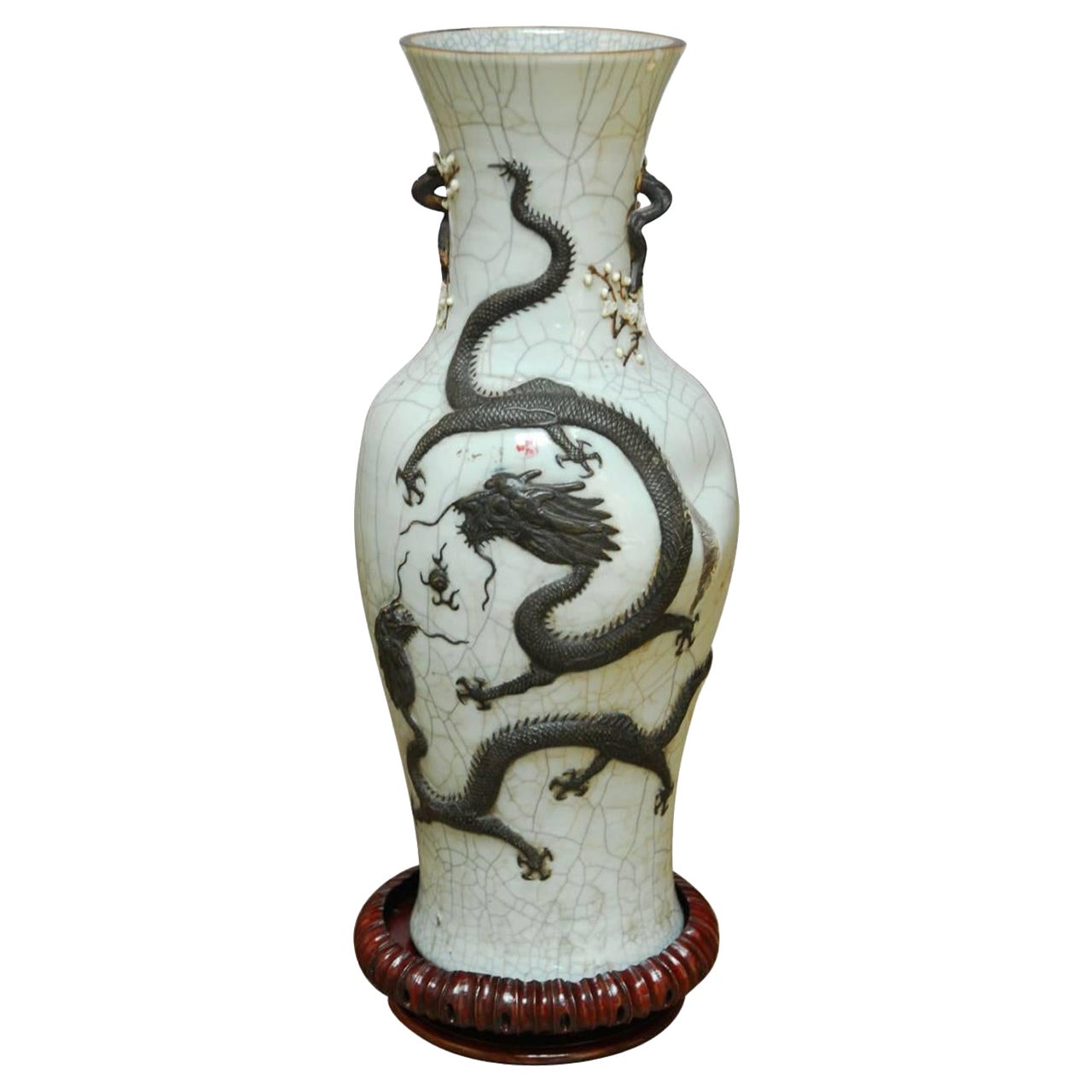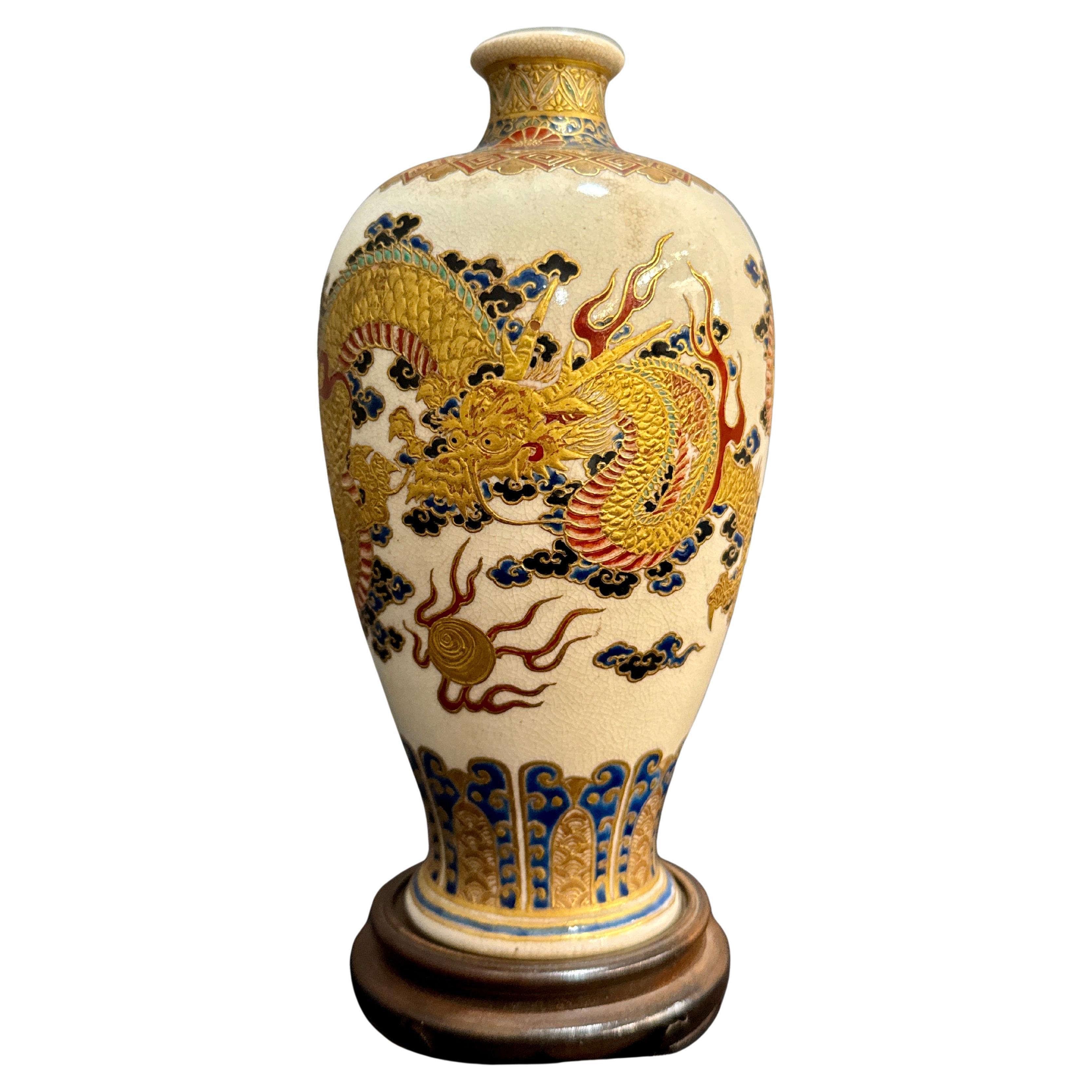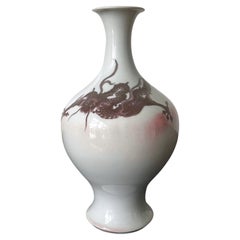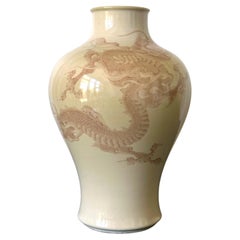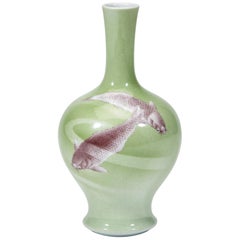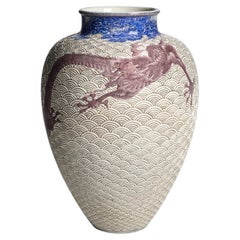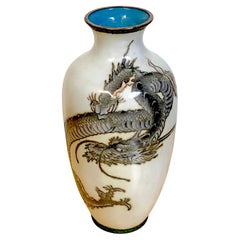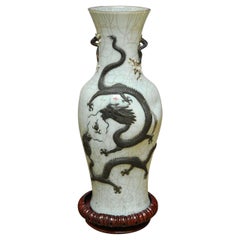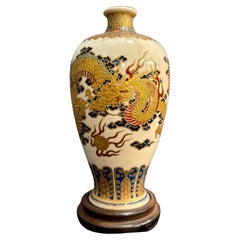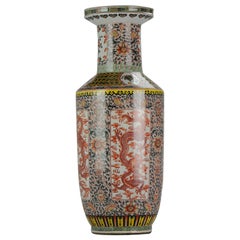Items Similar to Japanese Porcelain Dragon Glazed Vase Mazuku Kozan
Want more images or videos?
Request additional images or videos from the seller
1 of 16
Japanese Porcelain Dragon Glazed Vase Mazuku Kozan
$7,800
£5,963.52
€6,868.76
CA$10,930.19
A$12,202.53
CHF 6,393.94
MX$149,370.96
NOK 81,203.14
SEK 76,564.25
DKK 51,262.30
About the Item
A porcelain vase with dragon motif by Japanese imperial potter Makuzu Kozan (1842-1916), circa 1900s. The vase is made in what is considered early phase of his underglaze period during late Meiji era. In a classic elongated baluster form, the surface of the vase was decorated in an unusual pink mist on a white and aubergine background (called Morotai, the Hazy style), on which a flying dragon is showcased on the center. The dragon was outlined in iron red and filled with the aubergine color and was artistically emphasized on its bulging eyes, claws, scales and a long tail. It was the sole focus of the design circumventing the entire body of the vase. The imagery calls in mind the dragon decoration found in Korean Buncheong pottery, with its unique folklore vitality. The craftsmanship is superb with expertly use of colors and rendering of the motion. Kozan Studio experimented with newly available colors from the west starting in the 1880s, which resulted in the expansion of the palette and style that bridged the east and west aesthetic tradition. Marked in underglaze blue on the base with a collection number in red paint.
For a similarly decorated underglaze vase, see the Japanese reference book and the page in the last two photos.
Known also as Miyagawa Kozan (1842-1916), he is one of the most established and collected ceramist from Meiji Period. Born as Miyagawa Toranosuke, Kozan established his pottery studio in Yokohama circa 1870s and later became one of the appointed artists to the Japanese Imperial household. His work was exhibited in many international fairs that the Meiji government participated at the turn of the century and won many grand prizes.
- Creator:Makuzu Kozan (Artist)
- Dimensions:Height: 11 in (27.94 cm)Diameter: 5 in (12.7 cm)
- Style:Japonisme (Of the Period)
- Materials and Techniques:
- Place of Origin:
- Period:1900-1909
- Date of Manufacture:1890s-1900s
- Condition:Wear consistent with age and use. Fine condition with minimal wear. Marked number on the base as shown.
- Seller Location:Atlanta, GA
- Reference Number:1stDibs: LU945019280422
About the Seller
4.9
Platinum Seller
Premium sellers with a 4.7+ rating and 24-hour response times
Established in 2006
1stDibs seller since 2010
565 sales on 1stDibs
Typical response time: <1 hour
- ShippingRetrieving quote...Shipping from: Atlanta, GA
- Return Policy
Authenticity Guarantee
In the unlikely event there’s an issue with an item’s authenticity, contact us within 1 year for a full refund. DetailsMoney-Back Guarantee
If your item is not as described, is damaged in transit, or does not arrive, contact us within 7 days for a full refund. Details24-Hour Cancellation
You have a 24-hour grace period in which to reconsider your purchase, with no questions asked.Vetted Professional Sellers
Our world-class sellers must adhere to strict standards for service and quality, maintaining the integrity of our listings.Price-Match Guarantee
If you find that a seller listed the same item for a lower price elsewhere, we’ll match it.Trusted Global Delivery
Our best-in-class carrier network provides specialized shipping options worldwide, including custom delivery.More From This Seller
View AllJapanese Porcelain Glazed Vase with Dragon Design Mazuku Kozan
By Makuzu Kozan
Located in Atlanta, GA
A porcelain vase with dragon design by Japanese imperial potter Makuzu Kozan (1842-1916), circa 1900s. The vase is made in what is considered early phase of his underglaze period during late Meiji era. In a classic baluster form, the surface of the vase was decorated with a slithering dragon in underglaze iron red circulating the exterior among pink clouds. The animated rendering of the dragon is fine and detailed, with five claws, scales, long tails and highlighted eyes. The pink cloud is misty and called Morotai or the hazy style, created with a unique technique developed in Kozan's studio called fuki-e by blowing the pigment powders onto the surface. Kozan Studio experimented with newly available colors from the west starting in the 1880s, which resulted in the expansion of the palette and style that bridged the east and west aesthetic tradition. Marked in underglaze blue on the base.
Known also as Miyagawa Kozan...
Category
Antique Early 1900s Japanese Japonisme Ceramics
Materials
Porcelain
Large Japanese Porcelain Dragon Vase by Makuzu Kozan Meiji Period
By Makuzu Kozan
Located in Atlanta, GA
Made by the studio of the legendary Japanese imperial potter Makuzu Kozan (1842-1916), this is a large porcelain vase glazed in a soft yellow color with a subtle gradient, on top of ...
Category
Early 20th Century Japanese Meiji Ceramics
Materials
Ceramic
Fine Japanese Ceramic Vase Makuzu Kozan Meiji Period
By Makuzu Kozan
Located in Atlanta, GA
A Japanese long neck porcelain vase circa 1900-1910s by the studio of Miyagawa Kozan (1842–1916), one of the most established and collected Japanese ceramist from the end of Meiji Period. Commonly known as Makuzu Kozan, which also appears as the signature on his work, his originally birth name was Miyagawa Toranosuke. He was the appointed artist to the Japanese Imperial household and his work was exhibited in many international fairs that the Meiji government participated at the turn of the century.
This vase features an elegant Classic form with a slender neck and slightly flared mouth above a baluster body. It was finely painted with two swimming carps in a copper red underglaze among green ribbons like waves. The background display a brilliant verdant green overall, Around the fish a poetic hazy effect was emphasized for a visual complexity by Fuki-e (the blow painting), an invention in Kozan's studio. The new technical development of chemical colors from the west was embraced circa 1900s in Kozan studio. This empowered the more creative experiments with not only colors, but also concept of dimension, which led Makuzu Kozan's work to become a bridge between East and West aesthetics. This is particularly evident in this vase with the Masterly details of the brush strokes, the expertly employment of gradient of color, and a very realistic and detailed rendering of the fish and their vivid motions.
For two similar examples of Kozan's work with similar carps decoration, see Page 148-149 of the book: Sekai ni Aisa Reta ya Kimono Miyagawa Kozan Makuzu...
Category
Early 20th Century Japanese Meiji Ceramics
Materials
Ceramic
Large Japanese Ceramic Vase by Makuzu Kozan Meiji Period
By Makuzu Kozan
Located in Atlanta, GA
A large Japanese ceramic vase by the celebrated Meiji imperial potter Makuzu Kozan (1842-1916) circa 1880-1890s. Dated to his underglaze phase post 1887 after he successfully mastered the new colors available from the west and used them to the best advantage in his work deeply rooted in Japanese aesthetics. The vase has an impressive size and was potted in the classic baluster form with an elegant proportion. The surface is decorated using a combination of techniques of low relief sculpturing...
Category
Antique Late 19th Century Japanese Meiji Ceramics
Materials
Ceramic
Early Porcelain Underglaze Dragon Ewer by Makuzu Kozan Meiji Period
By Makuzu Kozan
Located in Atlanta, GA
A porcelain ewer with fine underglaze iron red, brown and blue decoration made by the legendary Japanese imperial potter Makuzu Kozan (1842-1916), this relatively rare piece is dated to circa Meiji 23rd to 26th year (1890-1893) based on the mark used on the base. This is the starting period when the artists departed from his high-relief and gold gilt period and started focusing on making porcelain pieces with underglaze paint and experimented new colors. The ewer form is also relatively rare in the artist's survived repertoire compared to other forms.
The piece takes its shape from the prototype Chinese...
Category
Antique 1890s Japanese Meiji Ceramics
Materials
Ceramic
Early Japanese Satsuma Antique Vase
By Satsuma
Located in Atlanta, GA
An Satsuma ceramic stone ware vase, circa 19th century, around the end of the Edo and the beginning of Meiji period. In the form of a Classic garlic bottle whose prototype was from China, the white bodied piece is decorated with an early form of kin nishikide, the so called golden brocade, a palette of iron-red, blue, green, yellow, purple and black with golden highlight. The over glazed enamel paint shows a group of robed figures in a garden setting with a lion and three tigers. A transparent overall glaze shows very fine crackles. The design is relatively sparse with plenty of negative space in contrast to the Satsuma production from the late 19th century, when the trend became fussy and overly glitz, due to the influence by the perceived western taste for the export market. This piece may still be made for export but its pattern was more influenced by both Kyoto Pottery and the Kano school of painting compared to the export ware by the end of the 19th century onward to the early 20th century. It was believed by many that this was a result of Satsuma potters visiting Kyoto in the late seventeenth century to learn over glaze painting techniques.
There are some age glaze crackles especially around the foot. The piece is not signed in keeping with the earlier production before Satsuma ceramics...
Category
Antique Mid-19th Century Japanese Japonisme Ceramics
Materials
Ceramic
$2,850 Sale Price
25% Off
You May Also Like
Exquisite Japanese Wireless Cloisonné Dragon Motif Vase, Meiji / Taisho Period
Located in West Palm Beach, FL
Japanese Wireless Cloisonné Enamel Vase, likely from the Meiji period (1868–1912) or possibly the early Taisho period (1912–1926). The vase features a dynamic depiction of a Japanese...
Category
Early 20th Century Japanese Meiji Vases
Materials
Copper
Chinese Qing Dynasty Crackle Glazed Dragon Vase with Kiln Error
Located in Rio Vista, CA
20th century rare Qing dynasty crackled (GE) glazed vase with molded three dimensional dragon forms. This very fine quality vase is particularly interesting by the presence of a kiln...
Category
Early 20th Century Chinese Qing Ceramics
Materials
Earthenware, Porcelain
$1,800 Sale Price
35% Off
Japanese Satsuma Dragon Vase, Meiji Period, c 1900, Japan
By Satsuma
Located in Austin, TX
A fantastic small Japanese Satsuma vase with image of writhing dragons, Meiji Period, circa 1900, Japan.
The vase of elegant baluster form, with a slightly flared foot, slender body...
Category
Antique Early 1900s Japanese Meiji Ceramics
Materials
Ceramic, Porcelain, Pottery, Stoneware, Hardwood
China 20th Century Dragon Vase of Chinese Porcelain, Mid-20th Century
Located in Amsterdam, Noord Holland
A very nicely decorated Vase with a scene of red dragons on a black and yellow ground.
Absolute top quality painting of the 20th century.
14-6-19-6-2
Overall condition; Ver...
Category
20th Century Chinese Ceramics
Materials
Porcelain
$5,670 Sale Price
20% Off
Unusual Early 20th Century Makuzu Kozan Vase
By Makuzu Kozan
Located in London, GB
Decorated in iron-red and green enamels with an overall design of three shish frolicking with a brocade ball, signed on the base with an impressed seal Makuzu.
The storage box ti...
Category
Early 20th Century Japanese Meiji Ceramics
Materials
Porcelain
Japanese Porcelain Globular Jar with Dragon
Located in West Palm Beach, FL
A Japanese Porcelain globular jar with dragon design on a light brown ground, early 20th century, 10 by 8 in. (25.4 x 20.32 cm.).
Category
Early 20th Century More Asian Art, Objects and Furniture
Materials
Porcelain
More Ways To Browse
Antique Glazed Vases
Japanese Dragon
Porcelain Dragons
Blue Glaze Japan
Antique Japanese Dragon
Antique Iron Glaze
Antique Japanese Book
Underglaze Blue Japanese Porcelain
Dragon Blue And White
Porcelain Japanese 1900
Iron Dragon
Japanese Vases With Dragons
Antique Porcelain Fairings
Pink Asian Vase
Korean White Porcelain
Antique Korean Porcelain
Circa 1900 Japanese Vase
Japanese Blue Dragon
